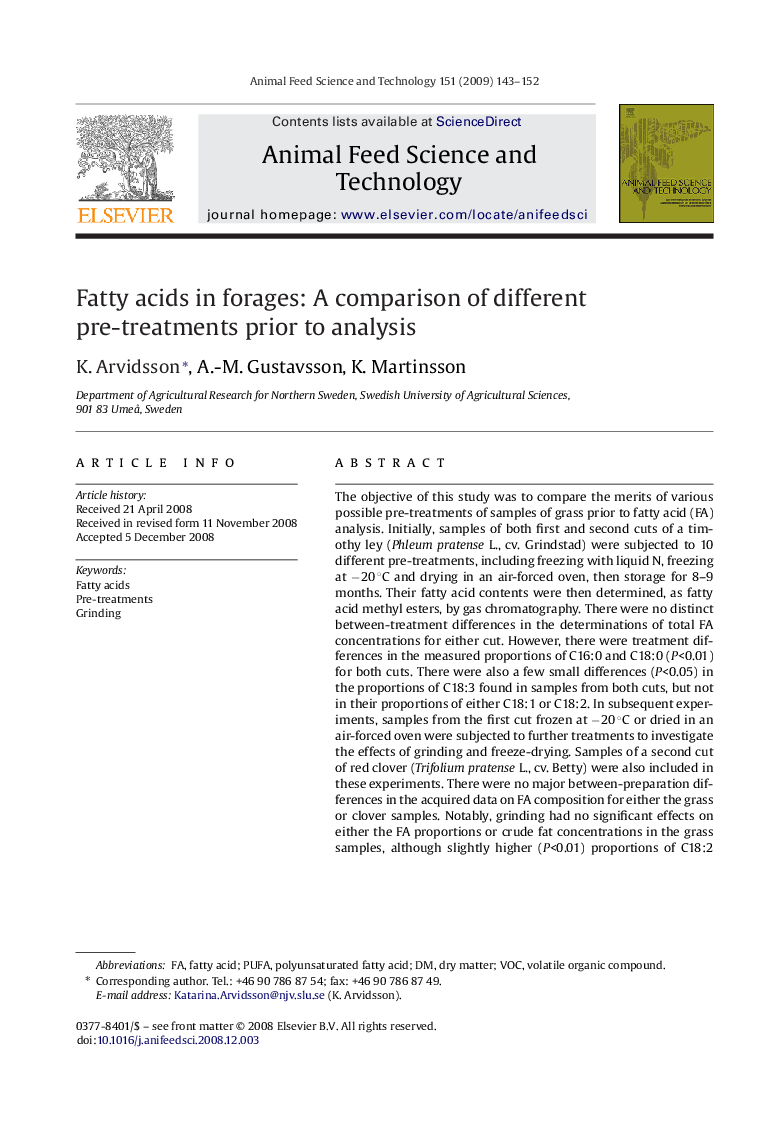| کد مقاله | کد نشریه | سال انتشار | مقاله انگلیسی | نسخه تمام متن |
|---|---|---|---|---|
| 2420294 | 1552458 | 2009 | 10 صفحه PDF | دانلود رایگان |

The objective of this study was to compare the merits of various possible pre-treatments of samples of grass prior to fatty acid (FA) analysis. Initially, samples of both first and second cuts of a timothy ley (Phleum pratense L., cv. Grindstad) were subjected to 10 different pre-treatments, including freezing with liquid N, freezing at −20 °C and drying in an air-forced oven, then storage for 8–9 months. Their fatty acid contents were then determined, as fatty acid methyl esters, by gas chromatography. There were no distinct between-treatment differences in the determinations of total FA concentrations for either cut. However, there were treatment differences in the measured proportions of C16:0 and C18:0 (P<0.01) for both cuts. There were also a few small differences (P<0.05) in the proportions of C18:3 found in samples from both cuts, but not in their proportions of either C18:1 or C18:2. In subsequent experiments, samples from the first cut frozen at −20 °C or dried in an air-forced oven were subjected to further treatments to investigate the effects of grinding and freeze-drying. Samples of a second cut of red clover (Trifolium pratense L., cv. Betty) were also included in these experiments. There were no major between-preparation differences in the acquired data on FA composition for either the grass or clover samples. Notably, grinding had no significant effects on either the FA proportions or crude fat concentrations in the grass samples, although slightly higher (P<0.01) proportions of C18:2 were found in the clover samples, and freeze-drying affected the FA proportions to some extent. In grass, freeze-drying resulted in lower (P<0.05) concentrations of C18:0 and C18:1 compared to freezing alone (−20 °C).If samples have to be stored for prolonged periods (such as the 8–9 months in this study) before analysis, drying seems to be a better treatment than freezing at −20 °C. Freezing with liquid N was not essential, at least for the examined forages, to obtain apparently reliable information on their FA profiles. Thus, the widely used method of preparing samples prior to analysis, i.e. freeze-drying and grinding, appears to be satisfactory, but drying samples seems to be as good or even better in some cases for analysing FA proportions.
Journal: Animal Feed Science and Technology - Volume 151, Issues 1–2, 12 May 2009, Pages 143–152